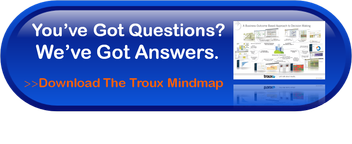Whole-Brained Business Analysis – New Metaphor Required
In attempts to explain the need for a more ‘whole-brained’ approach, I’ve been following the lead of the ‘Design Thinking’ community in referring to both Theory X and Theory Y from MIT Sloan and the Left-brain Right-brain metaphor. This, however, is fraught with problems due, in large part to the findings of the University of Utah who debunk such binary thinking (as I was reminded by Rob England – @theitskeptic).
So I’m in a quandary: on the one hand I find that an X-Y, Left-Right, metaphor is a simple way to convey the difference between, say, Analysis vs. Synthesis, on the other hand, however, I run the risk of aligning with outdated concepts being fundamental reconsidered by neuroscientists.
I guess the Complexity Science community might say that I’m talking about the difference between ‘Complex Adaptive’ vs. ‘Complicated’ systems, but, again, academic debate makes coming up with a simple metaphor next to impossible.
Has anyone found an alternative metaphor for a more balanced approach to Business Analysis and Enterprise Architecture?
Importantly, I’m keen to avoid the impression that people are to be seen as fundamentally one way or another. My observation is that it is the practice of Business Analysis/Enterprise Architecture that needs to be more ‘Whole-brained’ – not the individuals per se.
To get the discussion rolling, I’d like to hear views on:
- A good Business Analyst or Enterprise Architecture must be a balance of Left-X(Reliability – Doing-things-Right) and Right-Y (Validity – Doing-the-right-thing)
- We’ve spent to much time of methods that attempt to industrialise EA (the TOGAF 9.0 manual runs to around 800 pages in the attempt) and BAs are too often focused on methods focus on an ‘IT solution’ rather that the Whys and Whats of the current or desired business behavior
- We need to spend more time on developing pattern-based storytelling skills in BAs and EAs to deliver break-through changes and allow for innovation in TO-BE models.
- Economic churn and environmental challenges warrant more Y-minded thinking (with appropriate X-controls)
- The world can’t be fully explained or governed algorithmically (thank god!)– not while values and trust dominate the way organisations function.

 A traditional approach to Enterprise Architecture might suggest spending a significant amount of time (in some cases this could last as long as a year) gathering data from different parts of the business in the hope of building a holistic view of how the business looks today. Once you are sitting on this mass of data you may then consider EA tools to help you make sense of it all. To some people this seems a logical sequence– we’ll do the heavy data lifting on our end then call in the analytics guys to tell us what it all means. In reality this approach will often lead to wasted effort and set back the timetable for delivering value. As we discussed in a recent post,
A traditional approach to Enterprise Architecture might suggest spending a significant amount of time (in some cases this could last as long as a year) gathering data from different parts of the business in the hope of building a holistic view of how the business looks today. Once you are sitting on this mass of data you may then consider EA tools to help you make sense of it all. To some people this seems a logical sequence– we’ll do the heavy data lifting on our end then call in the analytics guys to tell us what it all means. In reality this approach will often lead to wasted effort and set back the timetable for delivering value. As we discussed in a recent post, 
